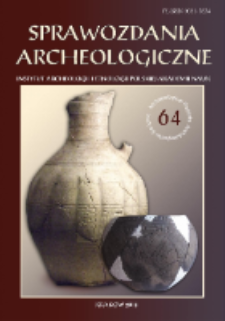
Obiekt
Tytuł: Ash wood and European hazel conservation with polyethylene glycol 400 using vacuum freeze drying in low temperature = Konserwacja jesionu i leszczyny poliglikolem etylenowym 400 z wykorzystaniem suszenia próżniowego w niskiej temperaturze
Twórca:
Grupa, Małgorzata ; Kaźmierczak, Ryszard ; Rybka, Krzysztof ; Płóciennik, Przemysław ; Zawadzka, Anna
Data wydania/powstania:
Typ zasobu:
Inny tytuł:
Sprawozdania Archeologiczne 64 (2012)
Wydawca:
Instytut Archeologii i Etnologii Polskiej Akademii Nauk
Miejsce wydania:
Opis:
Typ obiektu:
Abstrakt:
The article presents results of the research, performed on samples of waterlogged archaeological wood: ash wood and European hazel. The preservation process was carried out using 15% and 30% of PEG 400. The consolidation process was stabilized by freeze-drying method. Next, the samples’ hardness was tested by Janka’s method
Bibliografia:
Christensen B. 1970. The conservation of waterlogged wood in the National Museum of Denmark. Copenhagen
Chudziak W., Kaźmierczak R. and Niegowski J. 2011. Podwodne dziedzictwo archeologiczne. Toruń
Ciabach J. 1991. Właściwości żywic sztucznych stosowanych w konserwacji zabytków. Toruń
Cook R. and Grattan D. 1985. A Practical Comparitive Study of Treatments for Waterlogged Wood 3. Pretreatment Solutions for Freeze-Drying, ICOM-WWWG Proceedings 3, 219–239, Grenoble
Drążkowska A. and Grupa M. 2009. A test on carrying out re-conservation of leather artifacts using vaccum drying technique in low temperatur es. Sprawozdania Archeologiczne 61, 111–121
Drążkowska A., Grupa., Płóciennik P., Rybka K., Szatkowski J. and Zawadzka A. 2011. Using vacuum freeze-drying for waterlogged archaeological leather conservation, Sprawozdania Archeologiczne 63, 357–385
Grattan D. W. and Mathias C. 1986. Analysis of waterlogged wood: The value of chemical analysis and other simple methods in evaluating condition. Somerset Levels Paper 12, 6–12
Grupa M. 2009. Conservation of archaeological wood with poly[etylene] glycols — disadvantages and advantages. Annals of Warsaw University of Life Sciences — SGGW, Forest Wood Technology 67, 123–125
Grupa M., Płóciennik P. and Zawadzka A. 2008. Konserwacja mokrego drewna archeologicznego metodą suszenia próżniowego. In M. Birezowska (ed.), Biuletyn Konserwatorów Zabytków, Oddział Warmińsko-Mazurski 6, 133–145
Grupa M., Płóciennik P. and Zawadzka A. 2009. Conservation of waterlogged archaeological wood with polyethylene glycol 4000 using vaccum drying in low temperature. Sprawozdania Archeologiczne 61, 159–184
Hoffman P. 1979. Short Note on the Conservation Program for the Breman Cog, Conservation of Waterlogged Wood, 41–44, [ECU-299]
Muhlethaler B. 1973. Conservation of Waterlogged Wood and Leather. Paris
Organ R. 1958. Carbowax and Other Materials in the Treatment of Water-logged Paleolitic Wood. Studies in Conservation 4, 96
Rosa H. and Gussman L. 1991. Konservierungsversuche an Archäologischen Leder. Arbeitsblätter für Restauratoren 1, 85–89
Szczuka J. and Żurowski J. 1999. Materiałoznawstwo przemysłu drzewnego, Warszawa
Zborowska M. 2010. Badania zmian fizykochemicznych w drewnie wybranych gatunków liściastych po długotrwałym wpływie środowiska wodnego. Poznań
Zborowska M. and Łucejko Ż. 2011. Wybrane metody oceny stopnia degradacji mokrego drewna wykopaliskowego. In A. Pelczak and A. M. Wyrwa (eds.), Konserwacja drewna zabytkowego, Między teorią a praktyką (= Biblioteka Studiów Lednickich 23). Lednica, 47–57
Czasopismo/Seria/cykl:
Tom:
Strona pocz.:
Strona końc.:
Szczegółowy typ zasobu:
Format:
Identyfikator zasobu:
oai:rcin.org.pl:54730 ; 0081-3834
Źródło:
IAiE PAN, call no. P 244 ; IAiE PAN, call no. P 243 ; IAiE PAN, call no. P 245 ; kliknij tutaj, żeby przejść
Język:
Prawa:
Zasady wykorzystania:
Copyright-protected material. May be used within the limits of statutory user freedoms
Digitalizacja:
Institute of Archaeology and Ethnology of the Polish Academy of Sciences
Lokalizacja oryginału:
Library of the Institute of Archaeology and Ethnology of the Polish Academy of Sciences
Dostęp:
Kolekcje, do których przypisany jest obiekt:
- Repozytorium Cyfrowe Instytutów Naukowych > Kolekcje Partnerów > Instytut Archeologii i Etnologii PAN > Publikacje Pracowników i Wydawnictwa IAE PAN
- Repozytorium Cyfrowe Instytutów Naukowych > Kolekcje Partnerów > Instytut Archeologii i Etnologii PAN > Publikacje Pracowników i Wydawnictwa IAE PAN > Czasopisma bieżące
- Repozytorium Cyfrowe Instytutów Naukowych > Piśmiennictwo > Czasopisma/Artykuły
- Repozytorium Cyfrowe Instytutów Naukowych > Kolekcje Partnerów > Instytut Archeologii i Etnologii PAN > Publikacje Pracowników i Wydawnictwa IAE PAN > Czasopisma bieżące > Sprawozdania Archeologiczne
Data ostatniej modyfikacji:
2 lut 2022
Data dodania obiektu:
8 lip 2015
Liczba pobrań / odtworzeń:
564
Wszystkie dostępne wersje tego obiektu:
https://rcin.org.pl./publication/74924
Wyświetl opis w formacie RDF:
Wyświetl opis w formacie RDFa:
Wyświetl opis w formacie OAI-PMH:
Obiekty Podobne
Drążkowska, Anna Grupa, Małgorzata Płóciennik, Przemysław Rybka, Krzysztof Szatkowski, Janusz Zawadzka, Anna
Gorczyński, Tadeusz (1905–1982)
Grupa, Małgorzata (1958– )
Lityńska-Zajac, Maria
Dąbrowski, Mieczysław J.
Dyczek, Piotr Płóciennik, Przemysław Zawadzka, Anna
Perotto, Nicolò (1430–1480) Chojnacka, Anna Drozdek, Aneta Lesińska, Justyna Mazurkiewicz, Miriam Michurska, Kinga Zawadzka, Magdalena
Rybka, Krzysztof

 INSTYTUT ARCHEOLOGII I ETNOLOGII POLSKIEJ AKADEMII NAUK
INSTYTUT ARCHEOLOGII I ETNOLOGII POLSKIEJ AKADEMII NAUK
 INSTYTUT BADAŃ LITERACKICH POLSKIEJ AKADEMII NAUK
INSTYTUT BADAŃ LITERACKICH POLSKIEJ AKADEMII NAUK
 INSTYTUT BADAWCZY LEŚNICTWA
INSTYTUT BADAWCZY LEŚNICTWA
 INSTYTUT BIOLOGII DOŚWIADCZALNEJ IM. MARCELEGO NENCKIEGO POLSKIEJ AKADEMII NAUK
INSTYTUT BIOLOGII DOŚWIADCZALNEJ IM. MARCELEGO NENCKIEGO POLSKIEJ AKADEMII NAUK
 INSTYTUT BIOLOGII SSAKÓW POLSKIEJ AKADEMII NAUK
INSTYTUT BIOLOGII SSAKÓW POLSKIEJ AKADEMII NAUK
 INSTYTUT CHEMII FIZYCZNEJ PAN
INSTYTUT CHEMII FIZYCZNEJ PAN
 INSTYTUT CHEMII ORGANICZNEJ PAN
INSTYTUT CHEMII ORGANICZNEJ PAN
 INSTYTUT FILOZOFII I SOCJOLOGII PAN
INSTYTUT FILOZOFII I SOCJOLOGII PAN
 INSTYTUT GEOGRAFII I PRZESTRZENNEGO ZAGOSPODAROWANIA PAN
INSTYTUT GEOGRAFII I PRZESTRZENNEGO ZAGOSPODAROWANIA PAN
 INSTYTUT HISTORII im. TADEUSZA MANTEUFFLA POLSKIEJ AKADEMII NAUK
INSTYTUT HISTORII im. TADEUSZA MANTEUFFLA POLSKIEJ AKADEMII NAUK
 INSTYTUT JĘZYKA POLSKIEGO POLSKIEJ AKADEMII NAUK
INSTYTUT JĘZYKA POLSKIEGO POLSKIEJ AKADEMII NAUK
 INSTYTUT MATEMATYCZNY PAN
INSTYTUT MATEMATYCZNY PAN
 INSTYTUT MEDYCYNY DOŚWIADCZALNEJ I KLINICZNEJ IM.MIROSŁAWA MOSSAKOWSKIEGO POLSKIEJ AKADEMII NAUK
INSTYTUT MEDYCYNY DOŚWIADCZALNEJ I KLINICZNEJ IM.MIROSŁAWA MOSSAKOWSKIEGO POLSKIEJ AKADEMII NAUK
 INSTYTUT PODSTAWOWYCH PROBLEMÓW TECHNIKI PAN
INSTYTUT PODSTAWOWYCH PROBLEMÓW TECHNIKI PAN
 INSTYTUT SLAWISTYKI PAN
INSTYTUT SLAWISTYKI PAN
 SIEĆ BADAWCZA ŁUKASIEWICZ - INSTYTUT TECHNOLOGII MATERIAŁÓW ELEKTRONICZNYCH
SIEĆ BADAWCZA ŁUKASIEWICZ - INSTYTUT TECHNOLOGII MATERIAŁÓW ELEKTRONICZNYCH
 MUZEUM I INSTYTUT ZOOLOGII POLSKIEJ AKADEMII NAUK
MUZEUM I INSTYTUT ZOOLOGII POLSKIEJ AKADEMII NAUK
 INSTYTUT BADAŃ SYSTEMOWYCH PAN
INSTYTUT BADAŃ SYSTEMOWYCH PAN
 INSTYTUT BOTANIKI IM. WŁADYSŁAWA SZAFERA POLSKIEJ AKADEMII NAUK
INSTYTUT BOTANIKI IM. WŁADYSŁAWA SZAFERA POLSKIEJ AKADEMII NAUK


































